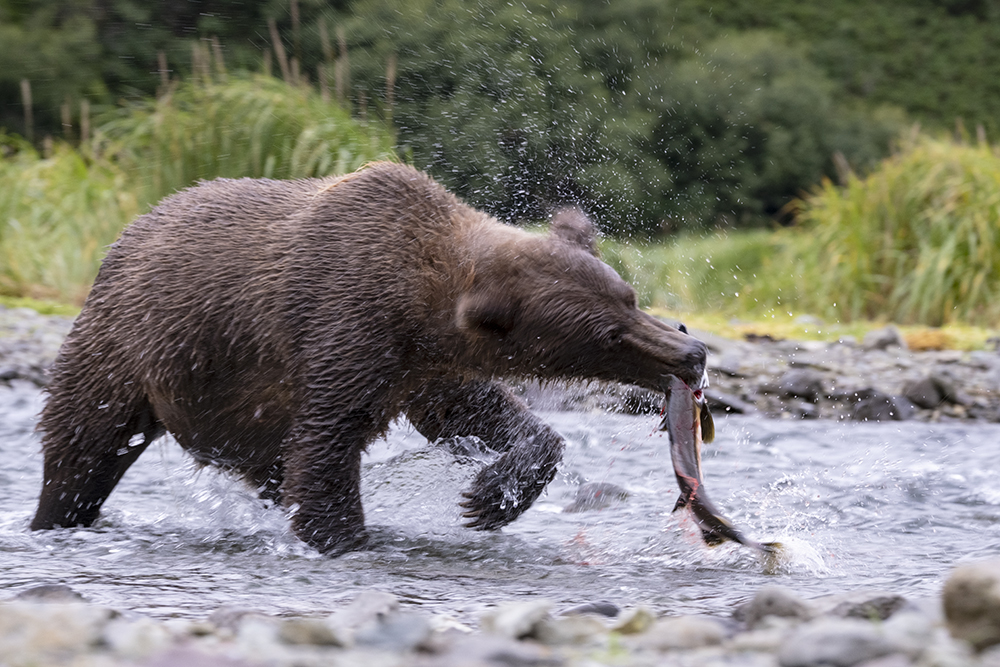The thought of getting up close and personal with a Grizzly bear in the wild is not something which many people would relish, but the opportunity carries a thrill. These apex predators have a fearsome reputation but, like any animal in its natural environment, this reputation is based on confrontation – often unexpected confrontation. Bears attack when they feel threatened or are protecting their young, sometimes when they are hungry, but not because it’s their first instinct to hunt human beings.



There are a few places in the world where it’s possible to get close to these majestic creatures – Alaska is one of the best, if not the best. In summer the salmon leave the Pacific Ocean, heading into coastal Alaska to spawn. Swimming up through the bays into a network of rivers they also travel into bear country and their long journey faces perhaps its biggest peril as fish meet bear. As with so much in nature, the cycles of predator and prey inter-connect. Almost as if scheduled in their diaries, the bears come down from the mountains to the coast to coincide with the arrival of the salmon, to feed and fatten up for winter.
Alaska is a beautiful but wild place – sparsely populated and difficult to explore. That is both a challenge for visitors but also a reason why it remains predominantly unspoilt. Whilst tourism is a part of life there, visitor numbers are relatively low and slow travel is very much the order of the day. Not least, it’s a long way from most places! Most visitors to this 49th state of the USA come by air or boat, or a combination of the two. Once there these two modes of transport are also the best way to get around. The car is very much a poor relation on the travel front, especially around its rugged coast.
One of the most amazing places to see the bears is the vast Katmai National Park to the west on Anchorage. There is a significantly large population of brown bears – Grizzlies are brown bears – in this park and it’s also an important location in the life cycle of a number of species of salmon. The sockeye salmon tend to spawn in lakes but many other varieties spawn in rivers running down from the mountains. Either way they meet the bears. This presents good opportunities to photograph the grizzlies as they coalesce to feed, triggering all the important ecological events which go hand-in-hand; the bears not the only beneficiary of the salmon returning to produce their next generation, as I quickly discovered.



I won’t be saying exactly where I went to photograph the salmon running this bear gauntlet. The reason for that is it’s a highly sensitive environment, not suited to mass tourism, and too many photographers turning up would not only impact this environment, but also intrude on the wild nature of the place and disturb the bears. Already there are arguably too many visitors. However, to get there involved a flight to Kodiak Island and then a sea plane to one of the best spots to see this natural phenomenon. There are only a few lodges in the park so ‘home’ for the five night visit was a live-aboard boat.
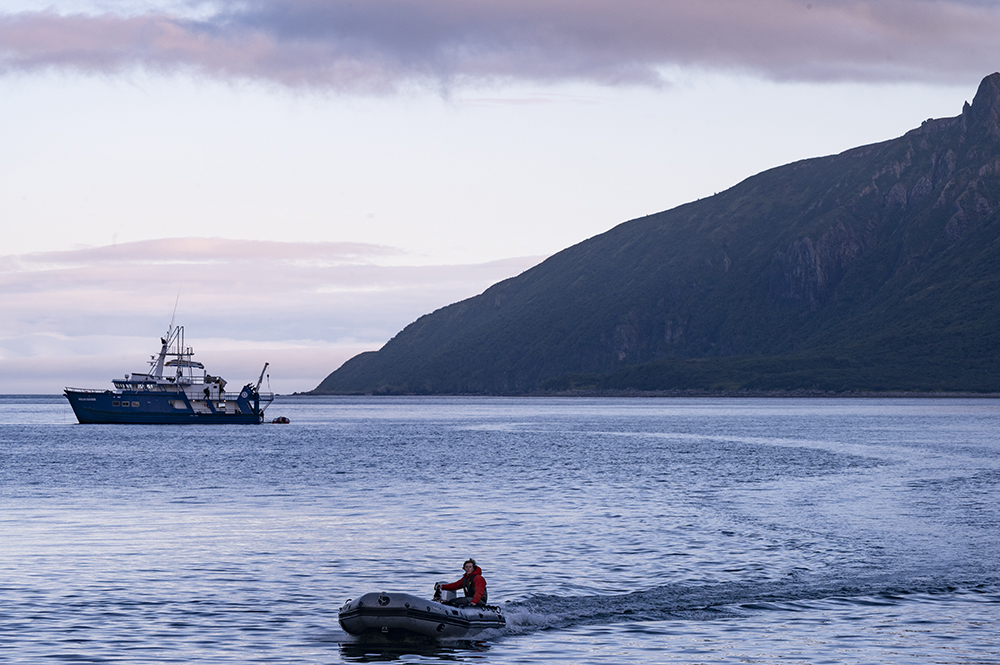
Before venturing on shore for the first encounter there was an all important safety briefing, not only for the boat moored in icy cold waters, but also on how to behave around these impressive predators in their own natural environment, and an alien one to me. Photographers tend to get carried away in the moment and in ‘getting the shot’, often losing all awareness of what’s happening around them. In the presence of an apex predator, which could come from any direction, this is very dangerous so we were guided by naturalist Erik Larson, a native of Alaska. The quality and proximity of bear interactions, and with these the photographic opportunities which present themselves, depends very much on how we behave in the bears’ territory to avoid being perceived as a threat. As long as people do this right, the bears aren’t interested in us and remain focused on hunting for salmon and filling their bellies.
The first trip to shore held an element of the unknown. How many bears would we see? How close would we get to them? The latter is, of course, a determining factor in deciding which lenses to take. Would long telephoto lenses be needed or would we get close enough for a shorter focal length? There’s always a fear of missing ‘the’ shot but sometimes it’s more important to just look, absorb the environment and plan than to go straight for the killer shots . With most wildlife photography, observation is key, resulting in better shots in the long run, so I opted to take just a mid-range zoom along with a determination to do more looking than photographing, viewing this first encounter more as a recce than photographic shoot.
A mother and two cubs keep an eye on the action, while other bears fish for salmon in the river.
The shoreline is reached by zodiacs from the live-aboard moored in the bay. Kitted out in waders and waterproof walking boots, we disembarked in the shallows and waded ashore. Bear activity is governed by the tides. As it rises the salmon journey upstream only to be trapped in the shallows as the tide goes out. This can also mean a long walk along the shoreline or in shallow water to return to the zodiacs after it’s gone back out and the shoreline’s receded.



To my surprise, there were lots of bears! As we came ashore I could see six or seven up ahead, and more in the distance, spread out as the river’s mouth widened into shallow streams to meet the sea. Under Erik’s guidance we slowly and cautiously moved closer and upstream towards the area where the most bears were fishing. It was fascinating to watch them. We were on their patch but provided our behaviour, guided by Erik, remained calm and unchallenging, the bears ignored us and focused on fishing.
How close do you think a bear would come? I expected maybe 15 metres, 10 metres if we were lucky. However, routinely they were only half a dozen metres from me and 200mm was much too long a lens focal length for anything but a head shot. On the second day a large female walked past me less three metres away! You’d think that this would be scary but although it was exhilarating, it was also strangely calming. The bears sense fear and this would also makes them much less comfortable with our presence in their space. Staying calm, as much in admiration of these powerful beasts, means they show very little interest in us intruders.
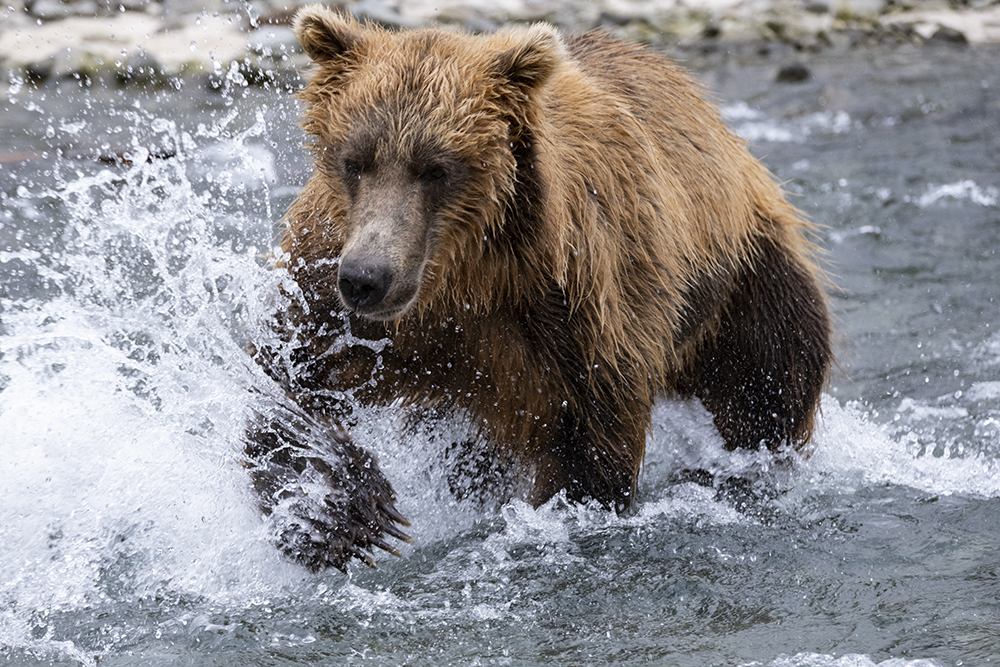
Close up – catching sight of their claws leaves you in know doubt that grizzles are anything but cute and cuddly.

When a bear attacks it is quick and focused. Capturing some motion blur adds to the sense of action.
Each encounter was different. Some lasted only a few seconds while others lingered as a bear, sometimes two, fished up and down the same stretch of rushing water. The weather wasn’t good for August. A front carrying rain had set in the day before I arrived. The seaplane from Kodiak to the boat was touch and go as to whether we’d even get there. This weather front lingered for most of my five days amongst the bears. Although this made things rather damp, in a way it was a blessing as it reduced contrast between highlights and shadows, compressing contrast and reducing the density of the shadows. The resultant shots had a more subtle tonal range and more detail. At times more contrast would have been helpful but generally less allowed more options for photographs.
Over the allotted days – five expeditions to observe and photograph the bears – I was able to try different lenses ranging from 16mm to 400mm. Surprisingly, to me at least, I found the range 70 to 100mm to be the most versatile and provide the most photographic opportunities, due to the closeness of the bears, but at time a longer telephoto was needed, or advisable to be able to shoot from a distance!
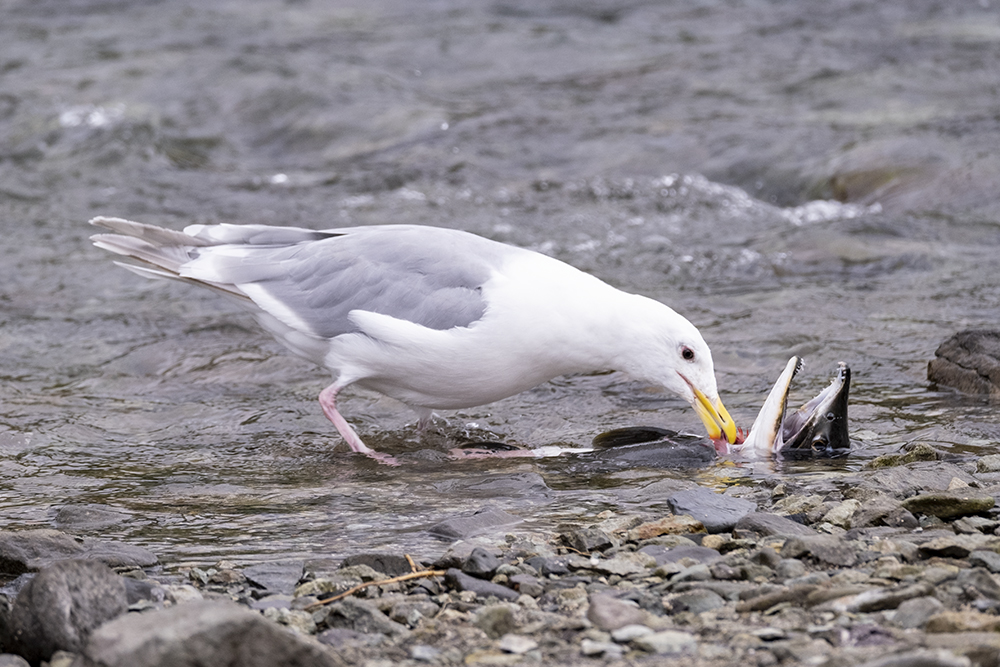
Of course, as with all wildlife photography, patience was essential. Bear activity close enough to photograph wasn’t constant but this allowed time to observe this small ecosystem and its other dependents. By far the most prevalent of these were the gulls – glaucous and kittiwakes. The bears were primarily after the fattier parts of the salmon – skin and main organs rather than the meat – so much of each fish was discarded with so many easy pickings. The rivers and streams were teeming with fish. The gulls noisily fought over and fed on the scraps left by the bears, but also sort out the roe, the eggs, washed down stream. Each discarded salmon induced a cacophony of gull shrieks.
When the bears weren’t nearby, I became fascinated by the juvenile kittiwakes. Their soft beige-grey plumage was striking. This is what first drew my attention, but one particular behaviour intrigued me – the way they fished for salmon roe. The birds would swim slowly upstream against the current, then every now and again would jump vertically and dive into the water, which was about 30cm deep, surfacing a little downstream with a small pale-coloured egg in beak. Closer observation revealed a pattern. As each bird readied itself to dive their neck would stiffen and tail twitch. This was the signal and if I wanted to capture the dive, the only clue that it was about to happen.



Kittiwakes in action diving for salmon scraps and roe
Capturing a dive in an image was much more challenging than you’d think, even with the gull’s advance notice. The whole thing happened very quickly. I worked out shutter speed to freeze the bird’s motion and set the frame rate on continuous low so that there was a noticeable difference from frame to frame, then tried my hand. Some of the jumps were low and I quickly realised these were not worth trying to capture, but others were much higher. As the bird jumped, there was a temptation to raise the camera with the jump and track the focus. A few failures and I quickly worked out that if I did this I’d miss the point of entry and/or the auto-focus would shift the focus point, resulting in blurry images at the point of entry. I needed to keep the camera on this point of entry and allow the dive to move through the frame. It took a few attempts, maybe 30 to 40 frames before I got something I was reasonably happy with, then a few more to get the shot I had pre-visualised (above).
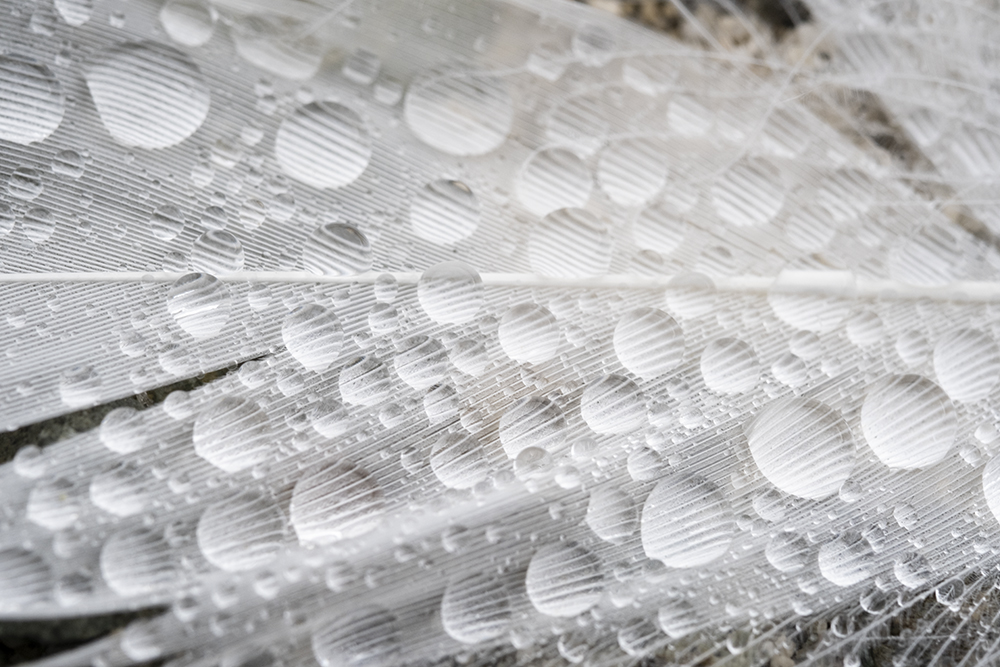
There were other photographic opportunities than these, some unexpected. Nearby there was a glaucous gull feather lying on the ashy sand – the region was mostly formed by volcanic activity and much of the rock is igneous. The feather was covered in water droplets and looked really beautiful. The macro lens came out of the bag and I whiled away some 10 to 15 minutes playing with abstract compositions. Judge for yourself if they work, but it was an interesting exercise in finding the small, and perhaps more engaging, amongst the larger scene.




The iconic bald eagle on it’s lookout in heavy rain and inflight; a small sea lion colony basking just off-shore
The first days of bear encounters were enthralling, yielding a range of different images. The boat then moved to a different bay along the coast, passing a sea lion colony and bald eagles on rocky outcrops en route. From the second bay it was a different bear-viewing experience involving a hike inland, using flattened bear trails through the reed beds, to an observation point across the river where the bears fished in a tumbling cascade of water and the pools which formed below. There wasn’t the opportunity to move around to get many varied angles of view from here, so different lenses came more into play.




The main falls were some 25 to 30 metres away, with the pools of varying depth directly below them. We were positioned at the head of one of the many bear trails which lead into these pools, so vigilance was needed at all times. It’s surprising how quietly and stealthily these big beasts move and on more than one occasion a bear approached from behind and was only about 3 to 4 metres away before we were even aware of it. They are inquisitive, sniffing the air for scent as they approach somewhat wearily. Only on one occasion all week did we experience even the slightest sign of aggression when another photographer failed to observe protocol. The result was a sharp but brief indication of displeasure from a very large grizzly – a growl as it thumped its front paws just once on the ground.


Longer lenses presented lots of photographic opportunities for individual bears here, especially those swimming and wading close by, and for tighter shots of the bears on the cascade. Working closely and carefully with Erik, I was at one point also able to wade about halfway across the pool to photograph a swimming bear from only a few metres away with a wide angle lens. Mothers with cubs, usually two, made for good group shots most often with a mid-range zoom.

Of course, any trip to the middle of nowhere wouldn’t be complete without a minor disaster. I don’t know if it was the previous day’s rain penetrating the camera – even though it is weatherproof to a degree and I was careful to keep it as dry as possible – but from working fine hours, it decided to play dead… completely dead! Back on the boat, out came the bag of rice and the warmth of a drying room, but to no avail. Although there was no chance of getting a replacement out in Katmai, the photographer I was with lent me his spare so I could at least keep shooting. Phew! The camera did come back to life 24 hours later though, but without a working screen it was like shooting on film again and actually rather liberating.
During this period between camera death and a borrowed salvation, a remarkable and rare event unfolded. The ocean around the boat erupted with thousands of jellyfish as the next generation was born all at once. It was magical. I suspect not many people have ever witnessed a spawning event like this. Sadly I could only capture it on an iPhone but the short video clip here gives you a sense of the wonder of seeing this happen.
It was a real privilege to be in this environment, amongst the bears. With Erik’s watchful eyes and guidance I didn’t feel threatened at any time, but I was ever-vigilant and constantly conscious of what was going on around me. It would have been easy to get it wrong and get into real danger very quickly. I couldn’t imagine a similar experience being remotely possible amongst some other apex predators though. The big cats for example. The whole experience gave me a deep respect for these giants of the Alaskan wilderness.
The time came to leave but that time, in remote places, is often not ours to choose. A 9am departure turned into a waiting game as the sea plane from Kodiak Island searched for a window of visibility to come and pick us up. It’s always wise to build a weather day into a travel itinerary in remote places, and during that wait two potential onward flight connections were missed. In the wilderness, with no phone signal, rearranging onward travel had to wait until we got back to Kodiak Island. Everyone else travelling out from there by plane was in the same situation with all flights cancelled. This resulted in an overnight stay in Kodiak and a scramble to find somewhere to sleep in a small town with few hotel rooms. In places like this, though, there is a strong sense of community and always someone to help out in a difficult and unexpected situation.

Adventures like this leave lasting memories – Mother and cub checking me out from the reedbed
Reflecting on the experience, I feel humbled to have been able to observe and share this time with some of Alaska’s Grizzlies. Photographically it was both stimulating and challenging, the latter to try to shoot something both interesting and original. The obvious shots were just there in front of you. It was also a reset on a human level – food for the soul. Time in wild nature, away from the screens and mobile phones which both dominate and diminish our lives so much of the time. It’s amazing how, without modern life’s encumberments, stress dissipates and time becomes only about light and dark, weather and tides. Living somehow feels much richer as a result.


